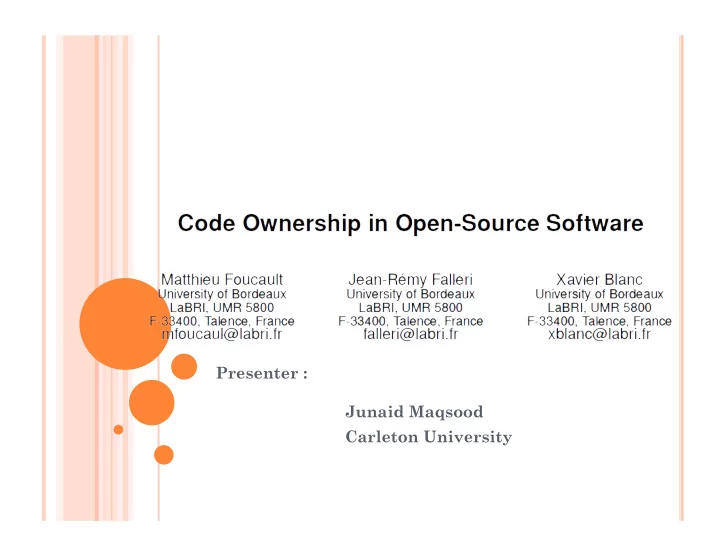

Presenter : Junaid Maqsood Carleton University
O UTLINE : � Background Information � Ownership Metrics � Proposed Replication � Results � Explanation As Per The Paper � Conclusion � Discussion
B ACKGROUND I NFORMATION � What C. Bird et al. did (Microsoft Research)(2011) � Their Proposed Study ( “The Original Study” ) � “correlation between the number of faults identified on a file and its number of authors” � Minor VS Major contributor. � Found out 50% of the time minor contributor on a module was a major contributor on a dependent module. � Dataset (Windows Vista and Windows 7) � Their Conclusion � (Conclusion Based on industrial Product) � Taken from this paper � “The goal of the original study by Bird et al. was to evaluate whether analyzing how many developers contributed to a project and in which proportions influenced the fault-proneness of software module” � “The Purpose of this study”(2014)
O WNERSHIP M ETRICS � Developers Contribution Equation � Ownership of a Source Code � Minor Developer � Major Developer
P ROPOSED R EPLICATION � Original Study was on Industrial Products � They used seven Java based Open source Projects � Aim to generalize “Ownership law” � Problems : � There is no standard for fault tracking in majority of open source software's. While the original study had access to Microsoft’s tool for fault management. � The data they gathered had only partial information regarding only post-release faults. While original study had access to both post and pre-release faults.
P ROPOSED R EPLICATION : D ATASET � In Addition to the ownership metrics, another thing the both study’s authors analyzed was the affect of size of the module. � Does the size of module have higher correlation with quality ?
P ROPOSED R EPLICATION : D IFFERENCES � Size : � The Original study used windows binary to study the impact on quality. Java class are much smaller. � They Combined Java Class with Java Packages. � Analyzing Time Period: � The Original study had a constant time that they analyzed. From the start till the end of the project. � This study analyzed two time periods. From latest release to onwards and from the previous release to onwards. � Tools � The Original Study had access to Microsoft official project management and bug reporting systems. All details required were easily extracted. � This study gathered contributors information from various version control systems used by the projects.
R ESULTS : P ACKAGE L ATEST RELEASE � Code Metrics (Size) : Had the better positive correlation with the post faults in a package. � Ownership Metrics : Had in some case had some correlation but in many cases had no correlation with the faults.
R ESULTS : F ILE L ATEST RELEASE � Code Metrics (Size) along with Ownership Metrics had no correlation with the post-release faults.
R ESULTS : P ACKAGE W HOLE RELEASE � Code Metrics (Size) : Had the better positive correlation with the post faults in a package. � Ownership Metrics : Had no correlation with the faults in majority of the packages.
R ESULTS : F ILE W HOLE RELEASE � Code Metrics (Size) along with Ownership Metrics had no correlation with the post-release faults.
R ESULTS : D ISCUSSION � Code Metrics was more correlated to the quality in terms of faults. � Number of Developers on a particular module had less or no affect upon the quality. � Type of the developer upon contribution also had no impact upon the number of faults. � The idea to generalize the “ownership law” did not lead to the expectation of the author. � Bird et al. found a strong correlation between ownership metrics and module faults in industrial projects whereas the results of this study of Java FLOSS projects are quite different.
E XPLANATION A S P ER T HE P APER � This may be due to the inherent differences between industrial and FLOSS projects. � Distribution of workload among developers. � Developers spend 100% effort on industrial paid projects � In Open-Source Projects � There are two basic contributor’s type � “Heroes” (Ones who contribute a lot) (Very less) � “Incidental Contributors” Ones who just do a single contribution, fix a bug and that’s it. � Size might not have been adequate enough to make a proper analysis. � Minor contributors in industrial project still are major developers on other modules. In OSS minors are just minors.
C ONCLUSION � In Industrial Products: (2011) (Don’t Touch My Code) � The ownership metrics have a certain correlation with faults. � More minor contributors = More pre and post-release bugs � Size of module is not that important in regard to quality. � In OSS (2014) (This Study) � Ownership metrics did not have a relation in terms of faults. � Size of module had a positive correlation with faults.
T HANK Y OU !!!!
D ISCUSSION : Q1 OF 3 � What do you think about the author’s explanation to the results?
D ISCUSSION : Q2 OF 3 � Author in terms of Future work. Proposed to study the impact of incidental contributors on OSS. � “Our hypothesis is that although incidental contributors do not have significant impact on the quality of a project, they introduce noise to the measures of ownership” � What do you think in regard to this future work ?
D ISCUSSION : Q3 OF 3 (LAST QUESTION) � Background To This question : � Law Of Diminishing returns � Do you think there is any similarity among this concept and the 2 studies.
Recommend
More recommend